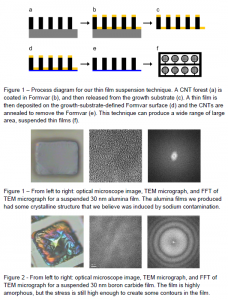Kyle Zufelt and Dr. Robert Davis, Department of Physics and Astronomy
My research proceeded more or less according to the plan that I proposed. What changed was that I realized there were many more details necessary to work out than what I had included in my proposal. By collaborating with professors in the physics and electrical engineering departments, I was able to find recipes that produced low-stress ceramic films, the difficulty was in finding a method to suspend these films over large areas. As expected, I was able to produce thinner, more stable films on a support than what had been previously reported for suspended films in the literature. Unfortunately, I first was depositing these films onto a rigid substrate, and then attempting to use a chemical etch to release the films. I quickly found that any sort of wet processing would destroy films of the thicknesses that I was producing. Think about putting a kite with very thin sails in water and moving it back and forth. The water pressure tends to burst the sails. For my project, once the films burst, they roll up on themselves like a piece of plastic wrap.
Next I tried depositing the films onto a support film that I could then remove by plasma etching. We theorized that the plasma etch could remove the support film without bursting the thin film that we were trying to preserve. Unfortunately, plasma etching of the materials I was using did not proceed uniformly across large areas, and so in some places I would see the plasma etch through both the support and the thin film, while in others the support was not yet entirely etched away. While some commercial processes rely on plasma etching, they generally require more expensive equipment, and careful tuning of the etch parameters. So we decided to put that method on the back burner, and to look for other options.
We realized that we needed some type of support on which to deposit the thin films, but this support needed to be removable by some process that ideally would not affect the thin films. We decided to look at polymers, which have relatively low temperature stability, in hopes that we could “evaporate” our support structure away. Several polymers that we looked at produced a carbon film when annealed, which was not ideal for our process. We finally settled on Formvar, a commercial polymer that leaves little to no carbon residue when annealed. By depositing thin films on Formvar, and then annealing the Formvar, we have created 30 nm thick, suspended alumina thin films and 25 nm thick, suspended boron carbide films.
We have created a versatile method for producing thin, suspended ceramic films. Future work could involve producing even thinner films to determine at what thickness our technique no longer works. We could also look at increasing the smoothness of the boron carbide thin films or increasing the purity of the alumina thin films.

